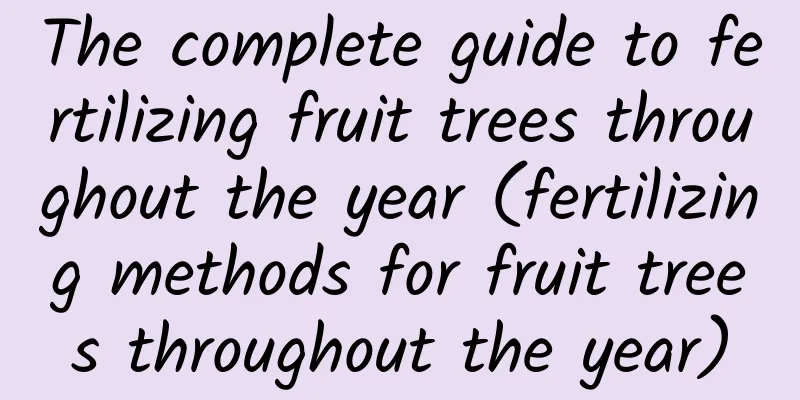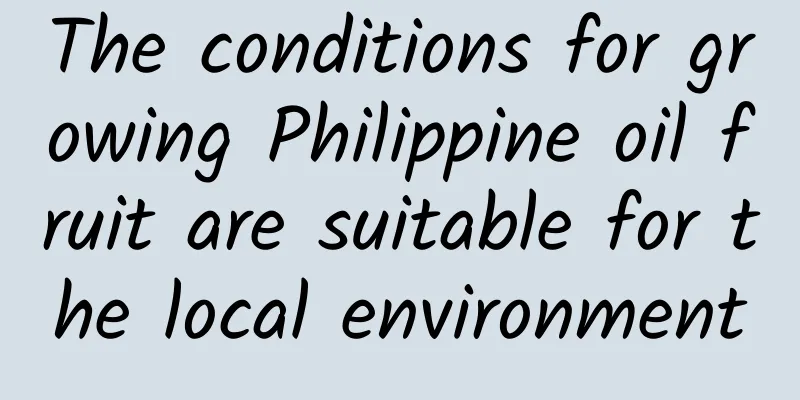The complete guide to fertilizing fruit trees throughout the year (fertilizing methods for fruit trees throughout the year)

|
In the planting and management of fruit trees, there has always been a saying that "fruit trees should be fertilized on the third, sixth, and ninth day of the month" , which is what we fruit farmers usually say and do: spring fertilization, summer fertilization, and autumn fertilization. Which month is the best time to fertilize fruit trees throughout the year?The best time to fertilize fruit trees in spring is generally from early March to mid-April . The best time to fertilize fruit trees in summer is from mid-June to early July. The best time to fertilize fruit trees in autumn is generally from early to mid-September to the end of October . These three fertilization periods not only correspond exactly to the "three, six, and nine" in fruit tree fertilization, but also correspond to the three peak root growth periods of fruit trees: spring root growth, summer root growth, and autumn root growth. In addition, the main purpose of fertilizing fruit trees in March in spring is to protect flowers and fruits (promote germination, leaf expansion, flowering and fruit setting), the main purpose of fertilizing in June in summer is to promote flowering and fruit expansion (promote flower bud differentiation and young fruit expansion), and the main purpose of fertilizing in September in autumn is to promote root growth and tree strengthening (promote root growth and tree vigor rejuvenation). Spring fertilization of fruit trees: promoting shoot growth, flowering and fruit preservationSpring fertilization of fruit trees is a critical period for the trees to store nutrients. The best time to fertilize is before the fruit trees sprout and before they bloom (approximately March-April). During this period, the nutrients accumulated by the fruit trees in the previous autumn have been basically consumed, and there is an urgent need to increase and reserve nutrients in the trees through fertilization. Fertilizing at this time is to accumulate sufficient nutrients for the subsequent germination, leaf expansion, flowering, fruit setting, and rapid growth of spring shoots and roots. If insufficient fertilizer is applied during this period, not only will the normal growth of new buds, new leaves, new shoots and new roots of the fruit trees be significantly inhibited, but it will also have a very adverse effect on the subsequent smooth flowering and fruiting of the fruit trees. Fruit trees that are fertilized with the correct type, method and amount of fertilizer in spring generally have the obvious advantages of rapid growth, large leaves, strong branches, well-developed root system, early flowering and high fruit set rate. Fruit trees that are not properly fertilized in spring will mostly have problems such as slow and weak growth of new shoots and leaves, poor flowering and fruit setting and quality, low flowering and fruit setting rate, large amount of flower and fruit drop, and low flower and fruit retention rate. In terms of spring fertilization of fruit trees, on the one hand, because the soil temperature is low and the root absorption capacity is weak at this time, it is not suitable to use a large number of trenching and soil damage methods to fertilize orchards in spring. Otherwise, excessive root damage will affect the transport of nutrients from bottom to top and weaken the growth of fruit trees in spring. On the other hand, fruit trees need to consume a lot of nitrogen fertilizer because of the growth of new shoots and leaves and the germination of roots in spring. Therefore, high-nitrogen fertilizers should be selected for orchard fertilization in spring (nitrogen fertilizer as the main fertilizer and appropriate amount of phosphorus and potassium fertilizers at the same time). Farmers who have the conditions are recommended to apply about 10 kilograms of microbial fertilizer per mu, and the fertilization effect will be more prominent. Regarding the method of fertilizing fruit trees in spring, it is better to fertilize early rather than late. Agricultural technician Xiaobeilu recommends that you try to complete the fertilization of the orchard 7-10 days before the fruit trees sprout. We try to choose high-nitrogen water-soluble fertilizers with strong quick-acting effect and high absorption and utilization rate for flushing. If you use conventional fertilizers, you can apply fertilizer by covering the soil at the roots. It is recommended that you try to use shallow fertilization methods in spring, such as spreading fertilizer in tree trays or digging shallow radial trenches. This will help minimize damage to the root system of fruit trees. When applying specific amounts of fertilizer to fruit trees in spring, we must consider three aspects: the amount of base fertilizer applied in the previous autumn, the strength of the trees, and the amount of flower buds formed. For fruit trees that had sufficient fertilizer at the end of last year, have strong tree vigor, and have a moderate number of flower buds, you can apply less fertilizer before budding in spring. For fruit trees that were insufficiently fertilized at the end of last year, have weak tree vigor, have a large number of flower buds, and for orchards that are having a poor fruit-bearing year this year (especially weak trees and fruit trees with a large number of flowers), more fertilizer should be applied before spring buds break. Summer fertilization of fruit trees: promoting flowering and fruit expansionThe best time to fertilize fruit trees in summer is after the new shoots of the fruit trees stop growing and before the flower buds differentiate. In terms of the specific time of fertilization, it is generally most appropriate to fertilize fruit trees in summer in the middle and early June . Fertilizing too early or too late is not conducive to promoting flowering and fruiting of fruit trees. When fertilizing fruit trees in summer, not only have the spring shoots of fruit trees basically stopped growing, but also the young fruits of fruit trees are entering the first rapid expansion and development period, and the flower buds on the fruit trees are about to enter the critical period of concentrated differentiation. At the same time, the root system of fruit trees (summer roots) will usher in the second growth peak of the year. Applying summer fertilizer to fruit trees in time at this time has several effects: On the one hand, it can promote the rapid expansion and development of young fruits; On the other hand, it can promote the differentiation of sufficient and high-quality flower buds; On the other hand, it can also promote the vigorous growth of fruit tree roots in summer. Therefore, top dressing of fruit trees around June in summer is very important. Proper management of this fertilization can not only ensure high yield and harvest of fruit trees in the current year, but also ensure a good foundation for the fruit trees to bloom and bear fruit smoothly in the next year. If the fruit trees are not properly fertilized in summer, the nutrients stored in the trees in the early stage will be basically consumed, resulting in a gap in nutrient supply for the fruit trees. Not only will a large number of young fruits fall off (physiological fruit drop is aggravated) and the quality of flower bud differentiation is poor, but young fruits in the first rapid expansion and development period will also be small in size and poor in quality due to insufficient nutrition supply, resulting in reduced production in the later stage. When choosing the type of fertilizer for fruit trees in summer, because the nutritional growth of fruit trees (branches and leaves) basically stops at this time, the focus of growth has shifted to reproductive growth (flowers and fruits), so the focus of fertilization at this time should be on supplementing potassium, phosphorus and controlling nitrogen. Therefore, it is recommended that when applying fertilizer to fruit trees in summer, it is best to choose high-potassium fertilizers that take effect quickly. For example, high-potassium, medium/low-phosphorus, and low-nitrogen fertilizers are more appropriate. If the fruit trees in the orchard are in poor condition, you can also use nitrogen-phosphorus-potassium balanced fertilizer. The specific fertilizer to be chosen should be flexible based on the actual situation of your own fruit trees. It is recommended that you choose water-soluble fertilizers with good water solubility, good effectiveness and high nutrient absorption and utilization rate when applying fertilizers in summer. If you are using conventional fertilizers (such as compound fertilizers, urea, potassium sulfate, etc.), it is recommended that you use them in conjunction with watering. After fertilizing, water should be applied immediately to dilute the fertilizer concentration and promote absorption by the fruit tree roots. In terms of summer fertilization for fruit trees, farmers who have the conditions should adopt the method of integrated water and fertilizer (such as drip irrigation), or use water-soluble fertilizer for flushing. In addition, we can also use conventional fertilizers for hole application or furrow application. When fertilizing fruit trees in summer, in addition to fertilizing the roots, in order to better promote flowering and fruit expansion, it is recommended that you make a combination of large, medium and trace amounts of fertilizers. During this period, it is best to use foliar fertilizers such as potassium dihydrogen phosphate, tetrahydrate octabor (boron fertilizer), chelated calcium (calcium fertilizer), chelated zinc (zinc fertilizer) and so on to spray continuously 2-3 times, spraying once every 7-10 days. This ensures that the fruit trees are fully and adequately supplied with nutrients, avoiding nutrient deficiencies during the growth period that may affect the development of flowers and fruits or induce various physiological diseases. Autumn fertilization of fruit trees: promoting root growth and strengthening trees Autumn fertilization of fruit trees is the most important fertilization in the annual fertilization management of fruit trees. By applying reasonable and sufficient fertilizer to fruit trees in autumn, we can not only help the weak trees quickly replenish nutrients after a year of branch and leaf growth and flowering and fruiting, but also quickly restore their vigor. At the same time, fertilizing at this time can also encourage fruit trees to store more nutrients before their leaves fall in autumn and winter, so as to lay a solid nutritional foundation for the fruit trees to survive the winter smoothly and to sprout, grow leaves, bloom, and fruit set smoothly in the spring of the following year. In addition, autumn is the third peak period of root growth for fruit trees (autumn is the longest root growth period for fruit trees). Applying autumn fertilizer at the right time and early can also allow fruit trees to grow more new roots and absorb fertilizer nutrients more effectively. Regarding the time management of fertilizing fruit trees in autumn, it is generally more appropriate to fertilize after the autumn shoots of fruit trees stop growing. The fertilizers should be of complete types and sufficient in quantity. The general time for fertilizing fruit trees in autumn is around September and October. If it is a fruit tree variety that matures early, it is recommended to fertilize within 7-10 days after the fruit is harvested. If it is a medium or late-maturing fruit tree variety with a later maturity period, then the agricultural technician Xiaobeilou recommends that you try to apply fertilizer before the fruit is harvested. Early application of autumn fertilizer can allow the fruit trees to replenish nutrients early and recover sooner. This will also help the fruit trees absorb nutrients early and prolong the time for the leaves to produce nutrients through photosynthesis, allowing the fruit trees to store more nutrients before winter. When choosing fertilizers for fertilizing fruit trees in autumn, you should pay attention to ensuring that the fruit trees are "full" and "fully fed and well fed." At the same time, we also need to provide fruit trees with nutrients that can be "absorbed and utilized for a long time." Therefore, in the autumn fertilization management of fruit trees, we fruit farmers should not only use long-acting and slow-acting organic fertilizers or decomposed farmyard manure as the main types of fertilizers, but also use appropriate amounts of nitrogen, phosphorus and potassium fertilizers according to the age of the trees, the amount of fruit, and the strength of the trees. In addition, for orchards with nutrient deficiencies, a certain amount of medium and trace elements such as calcium, zinc, iron, and boron should be reasonably applied (medium and trace element fertilizers can also be sprayed on the leaves). When applying autumn fertilizer to fruit trees, deep plowing of the orchard land and watering of the orchard should be combined. |
Recommend
What is the best way to treat yellowing lucky bamboo leaves?
With its elegant posture and evergreen leaves, lu...
The legend of pale bamboo leaves
The legend of pale bamboo leaves According to his...
How to make Clematis bloom more
1. Flowering period Its flowering period is relat...
Can maple trees be planted in Guangxi?
Can maple trees be planted in Guangxi? Maple tree...
How to grow hyacinth in hydroponics
1. Planting bulbs When you get the hyacinth, wash...
How to reproduce soapwort
Selection of branches Today I will mainly introdu...
Cultivation methods and maintenance matters of old bougainvillea piles
How to grow bougainvillea into an old pile Bougai...
How to grow the genus Artemisia (is it better to use a high pot or a shallow pot for the genus Artemisia)
The variegated Master is relatively rare. There a...
The Feng Shui Effect of Cyclamen
1. Feng Shui Effect It is easy to see from the na...
How to water Ganoderma lucidum at home?
When many people go to the flower market, they of...
What to do if peppers have aphids
What to do if peppers have aphids When you find a...
Seabuckthorn seed cultivation method (seabuckthorn seed seedling propagation method and cultivation technology)
1. Key points of seabuckthorn seedling cultivatio...
The best way to prevent sheep from ruminating
When raising sheep, we often encounter situations...
How to deal with money tree after flowering
1. Meaning In fact, the flowering of this tree ha...
The meaning of the red spider lily, the meaning of the purple blue red spider lily
1. Introduction There are many meanings of the re...









